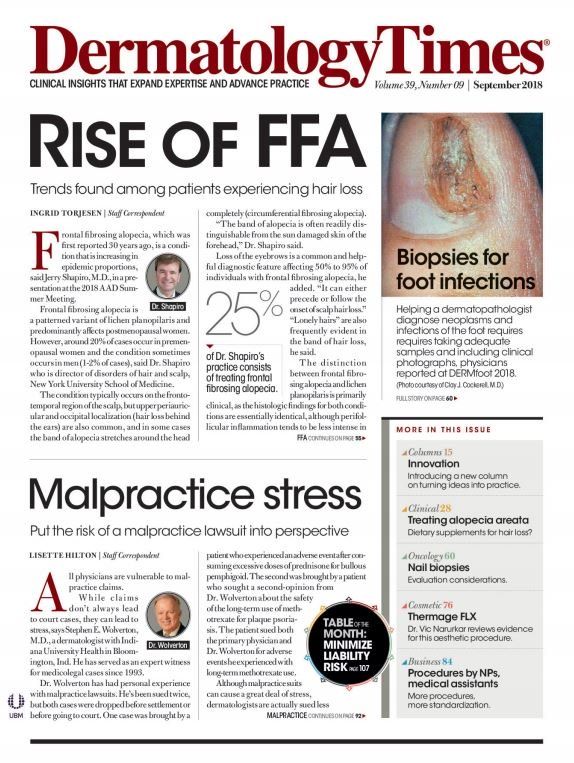- Case-Based Roundtable
- General Dermatology
- Eczema
- Chronic Hand Eczema
- Alopecia
- Aesthetics
- Vitiligo
- COVID-19
- Actinic Keratosis
- Precision Medicine and Biologics
- Rare Disease
- Wound Care
- Rosacea
- Psoriasis
- Psoriatic Arthritis
- Atopic Dermatitis
- Melasma
- NP and PA
- Skin Cancer
- Hidradenitis Suppurativa
- Drug Watch
- Pigmentary Disorders
- Acne
- Pediatric Dermatology
- Practice Management
- Prurigo Nodularis
- Buy-and-Bill
Publication
Article
Dermatology Times
Low recurrence of lentigo maligna with off-label neoadjuvant imiquimod use
Author(s):
Two to three months of neoadjuvant topical imiquimod, 5%, cream prior to conservatively staged excisions for lentigo maligna (LM) is associated with a low rate of recurrence.
Two to three months of neoadjuvant topical imiquimod, 5%, cream prior to conservatively staged excisions for lentigo maligna (LM) is associated with a low rate of recurrence. The rate of recurrence was similar to that reported with standard staged excisions by either Mohs surgery or en face permanent sections, reported Jessica M. Donigan, MD, from the University of Utah, Salt Lake City, and colleagues in JAMA Dermatology.
A total of 334 patients with 345 LM tumors treated with neoadjuvant imiquimod prior to undergoing conservatively staged excisions with 2-mm margins formed the study population. Patients were treated with imiquimid for 5 nights per week for a mean of 2.5 months. A mean of 1.2 stages were required to clear the tumor with a mean margin of 3.5 mm (median: 2.0 mm). Some 81% of patients had clear margins after 1 stage. Neoadjuvant imiquimod resulted in a narrower surgical margin compared with standard or staged excisions alone (median: 2 vs. 9.3 mm).
Thirty-seven patients were lost to follow-up; the mean length of follow-up for the remaining 297 was 5.5 years. The LM recurrence rate was 3.9% with a mean time to recurrence of 4.3 years. Two of the recurrences were invasive melanoma.
After removing patients who were included in a previously published study, 74 patients (with 75 tumors) in the cohort had used tazarotene in combination with imiquimod. The recurrence rate was 7.6% in the group receiving the combination compared with 2.9% in those receiving imiquimod alone, a difference that was not significant (P=0.19).
“Overall, these results support our opinion that neoadjuvant topical imiquimod allows for the confirmation of a negative histologic margin for LM, with a smaller mean surgical margin requirement with consequential lessened cosmetic penalty associated with the surgery,” the investigators concluded.
In an editorial to accompany the study, Fosko et al claim that the study suggests that the benefit of imiquimod in this setting may be its ability to effectively treat LM that extends beyond suspected clinical margins and the possibility that it traets background atypical melanocytic hyperplasia. They noted the wide variation in the efficacy of off-label imiquimod for LM reported in the literature. “Differences in imiquimod efficacy may be explained by variations in clinical presentation, host factors influencing immune response, variation in treatment frequency, duration and total applications, and the timing of posttreatment histopathologic assessment, making it difficult to group all LM together as a single disease,” they wrote.
A potential concern of nonsurgical techniques for LM, such as imiquimod, is the lack of histologic confirmation of clearance and accurate monitoring of disease response, they added, raising the possibility of using reflectance confocal microscopy to monitor disease response to imiquimod.
REFERENCES
Jessica M. Donigan, MD; Mark A. Hyde, MMS, PA-C; David Goldgar, PhD; et al. “Rate of recurrence of lentigo maligna treated with off-label neoadjuvant topical imiquimod, 5%, cream prior to conservatively staged excision,” JAMA Dermatology. Published online May 30, 2018. DOI:10.1001/jamadermatol.2018.0530
Scott W. Fosko, MD; Cristian P. Navarrete-Dechent, MD; Kishwer S. Nehal, MD. “Lentigo maligna-challenges, observations, imiquimod, confocal microscopy, and personalized treatment,” JAMA Dermatology. Published online May 30, 2018. DOI:10.1001/jamadermatol.2018.0531






